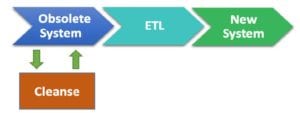O rganizations periodically encounter the need to replace obsolete enterprise systems as they reach end of life, face the loss of vendor support, or fail to keep up with evolving business requirements. One important step in the replacement process is the mapping and migration of the obsolete system’s data to the new system. Ideally, this migration process should be a straightforward extracttransform- load (ETL) exercise where existing data is:
- Extracted from the old system
- Transformed to a format supported by the replacement system
- Loaded into the new system
ETL success is dependent on the accuracy, completeness, and standardization of the source system’s data. Unfortunately, data in long-lived enterprise systems often fails these standards due to a number of factors that can include:
- Numerous administrators and data contributors (users) over time
- Multiple system ownership changes (e.g. owning department changes) with varying business needs and motivations
- Geographically dispersed operations
- Evolving business drivers and regulatory environments
- Acquisitions and mergers that contribute dissimilar data to the system
- Lack of consistent governance, configuration standards, and user training
These issues often result in a costly and time-consuming remediation process.
![]()








